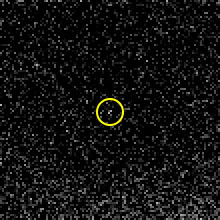Top Qs
Timeline
Chat
Perspective
Albiorix (moon)
Moon of Saturn From Wikipedia, the free encyclopedia
Remove ads
Albiorix /ˌælbiˈɒrɪks/ is a prograde irregular satellite of Saturn. It was discovered by Holman and colleagues in 2000, and given the temporary designation S/2000 S 11.[7][8][9]
Albiorix is the largest member of the Gallic group of irregular satellites.
Remove ads
Name
It was named in August 2003[10] for Albiorix, "a Gallic giant who was considered to be the king of the world."[11] The name is known from an inscription found near the French town of Sablet which connects him with the Roman god Mars.[12] It is still unclear if Albiorix was just an honorific suffix (lit. "Mars, king of the world") or a Celtic deity interpretatio with Mars.[13]
Remove ads
Orbit

Albiorix orbits Saturn at a distance of about 16 million kilometers. The rotation period was measured by the ISS camera of the Cassini spacecraft to 13 hours and 19 minutes.[14]
The diagram illustrates the Albiorigian orbit in relation to other prograde irregular satellites of Saturn. The eccentricity of the orbits is represented by the yellow segments extending from the pericentre to the apocentre.
Given the similarity of the orbital elements and the homogeneity of the physical characteristics with other members of the Gallic group, it was suggested that these satellites could have a common origin in the break-up of a larger moon.[6][9]
Remove ads
Physical characteristics

The James Webb Space Telescope took the spectrum of Albiorix with NIRSpec, detecting a 3.0 micron absorption feature associated with hydrated minerals, though water ice was not found to be present in substantial quantities. Additionally, carbon dioxide formed by irradiation of organic compounds was detected on Albiorix's surface. Albiorix appears nearly identical in its composition to Siarnaq, another Saturnian irregular satellite observed by James Webb Space Telescope.[15]
Measurements from NEOWISE constrain the albedo of Albiorix at 0.062±0.028, in which case its diameter is a rather large 28.6±5.4 km.[5] Albiorix is red in color, but some parts of its surface are less red than others. Varying colours suggest a possibility of a large crater, leading to an alternative hypothesis that Erriapus and Tarvos could be fragments of Albiorix following a near-break-up collision with another body.[16] It has a rotation period of 13.33±0.03 h, and while one light curve measured by Cassini–Huygens found two minima with a moderate perturbation in one of them, a different angle showed a sharp minimum and two shallower ones.
References
External links
Wikiwand - on
Seamless Wikipedia browsing. On steroids.
Remove ads

